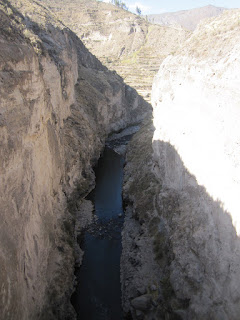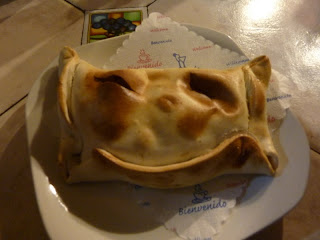 We arrived into Cuzco, bleary-eyed, just after 6:30, following our overnight bus journey from Arequipa. We headed straight for our awesome hotel, El Balcon, which we were staying in courtesy of Will and Sophie, who'd paid for our stay as an engagement present (thanks again guys!). The hotel boasted spectacular views over the red rooftops of the city – it put me in mind more of an Italian village than central Peru! I was expecting Cuzco to be a one-street tourist trap, existing only to sell tours and alpaca hats to tourists passing through en route to Machu Picchu, but it quickly became apparent that I was very wrong. Cuzco is in fact the oldest continually inhabited city in South America, and was the most important city of the Inca Empire, where most of the civilisation's rituals and ceremonies were held. Little wonder then that the Spanish felt it necessary to make their mark during the conquest.
We arrived into Cuzco, bleary-eyed, just after 6:30, following our overnight bus journey from Arequipa. We headed straight for our awesome hotel, El Balcon, which we were staying in courtesy of Will and Sophie, who'd paid for our stay as an engagement present (thanks again guys!). The hotel boasted spectacular views over the red rooftops of the city – it put me in mind more of an Italian village than central Peru! I was expecting Cuzco to be a one-street tourist trap, existing only to sell tours and alpaca hats to tourists passing through en route to Machu Picchu, but it quickly became apparent that I was very wrong. Cuzco is in fact the oldest continually inhabited city in South America, and was the most important city of the Inca Empire, where most of the civilisation's rituals and ceremonies were held. Little wonder then that the Spanish felt it necessary to make their mark during the conquest.We just had time for a quick shower and breakfast before Pete and Claire arrived from Lima. It was so fantastic to see them and catch up on all the news from home – James and I got a bit carried away, and ended up talking at them for an hour before we realised they hadn't even yet had time to check in to their rooms!
 Cuzco stands at 3400m above sea level, and so we'd planned in a couple of fairly restful days to adjust to the altitude before commencing our Inca Trail trek. We started with a leisurely lunch in a cafe overlooking the Plaza de Armas, watching the locals pass by in the sunshine. Eventually we decided that we'd probably better make at least an attempt at sightseeing, and so we headed across the plaza to the cathedral, which turned out to be three churches in one! We admired a statue of Black Jesus (no really!), and choir stalls featuring women with potatoes for stomachs, along with another painting of the Last Supper with guinea pig on the menu. It's been very interesting to see the combination of the traditional Andean religion and Spanish Catholicism – it seems that the Spaniards were happy for some local beliefs about Pachamama (Mother Earth) and other animistic rituals to continue, provided people fit them into the framework of the Catholic faith. At any rate, they seemed to achieve a compromise fairly well – the Virgin Mary is often pictured wearing an enormous dome-shaped dress, a subtle hint towards the traditional mountain shape of Pachamama.
Cuzco stands at 3400m above sea level, and so we'd planned in a couple of fairly restful days to adjust to the altitude before commencing our Inca Trail trek. We started with a leisurely lunch in a cafe overlooking the Plaza de Armas, watching the locals pass by in the sunshine. Eventually we decided that we'd probably better make at least an attempt at sightseeing, and so we headed across the plaza to the cathedral, which turned out to be three churches in one! We admired a statue of Black Jesus (no really!), and choir stalls featuring women with potatoes for stomachs, along with another painting of the Last Supper with guinea pig on the menu. It's been very interesting to see the combination of the traditional Andean religion and Spanish Catholicism – it seems that the Spaniards were happy for some local beliefs about Pachamama (Mother Earth) and other animistic rituals to continue, provided people fit them into the framework of the Catholic faith. At any rate, they seemed to achieve a compromise fairly well – the Virgin Mary is often pictured wearing an enormous dome-shaped dress, a subtle hint towards the traditional mountain shape of Pachamama. We also paid a visit to Qorikancha, an ancient Inca site converted by the Spaniards into the Church of Santa Domingo. The site was originally the central temple of the whole of Incan empire, created to worship the Gods of the Sun and of the Moon. When the Spanish arrived, they demolished the most important parts of it and rebuilt a Catholic church on the same site, but left other, smaller temples, to be used as dressing and preparation rooms by resident priests. Originally the outer Inca walls would have been covered in gold – what an amazing site must have greeted the Spanish on their arrival.
We also paid a visit to Qorikancha, an ancient Inca site converted by the Spaniards into the Church of Santa Domingo. The site was originally the central temple of the whole of Incan empire, created to worship the Gods of the Sun and of the Moon. When the Spanish arrived, they demolished the most important parts of it and rebuilt a Catholic church on the same site, but left other, smaller temples, to be used as dressing and preparation rooms by resident priests. Originally the outer Inca walls would have been covered in gold – what an amazing site must have greeted the Spanish on their arrival. The surviving structures today are still pretty spectacular - a hybrid Inca/Spanish site which dominates a whole quarter of the city. We found the famous Inca stonework particularly impressive – perfectly tessellating blocks of stone that have withstood hundreds of years of earthquakes whilst the modern buildings around them crashed to the ground. Our tour of the site was conducted by a Spanish woman with heavily accented English – she kept referring to 'Hypotetica' who we all thought was an ancient Inca King, until we realised she was actually saying hypothetically!
The surviving structures today are still pretty spectacular - a hybrid Inca/Spanish site which dominates a whole quarter of the city. We found the famous Inca stonework particularly impressive – perfectly tessellating blocks of stone that have withstood hundreds of years of earthquakes whilst the modern buildings around them crashed to the ground. Our tour of the site was conducted by a Spanish woman with heavily accented English – she kept referring to 'Hypotetica' who we all thought was an ancient Inca King, until we realised she was actually saying hypothetically!















































